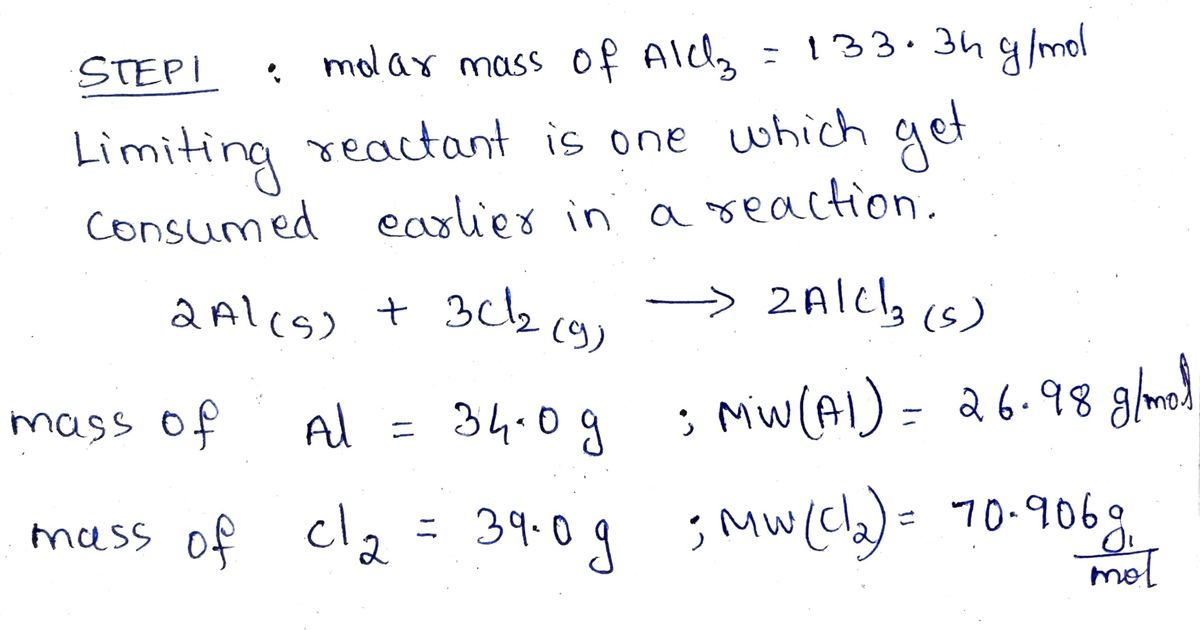Aluminum reacts with chlorine gas to form aluminum chloride via the following reaction: 2Al(s) + 3C12 (g)→2AICI3 (s) You are given 34.0 g of aluminum and 39.0 g of chlorine gas. Part A If you had excess chlorine, how many moles of of aluminum chloride could be produced from 34.0 g of aluminum? Express your answer to three significant figures and include the appropriate units. > View Available Hint(s) HA ? Value Units Part B If you had excess aluminum, how many moles of aluminum chloride could be produced from 39.0 g of chlorine gas, Cl2 ? Express your answer to three significant figures and include the appropriate units.
Aluminum reacts with chlorine gas to form aluminum chloride via the following reaction: 2Al(s) + 3C12 (g)→2AICI3 (s) You are given 34.0 g of aluminum and 39.0 g of chlorine gas. Part A If you had excess chlorine, how many moles of of aluminum chloride could be produced from 34.0 g of aluminum? Express your answer to three significant figures and include the appropriate units. > View Available Hint(s) HA ? Value Units Part B If you had excess aluminum, how many moles of aluminum chloride could be produced from 39.0 g of chlorine gas, Cl2 ? Express your answer to three significant figures and include the appropriate units.
Chemistry
10th Edition
ISBN:9781305957404
Author:Steven S. Zumdahl, Susan A. Zumdahl, Donald J. DeCoste
Publisher:Steven S. Zumdahl, Susan A. Zumdahl, Donald J. DeCoste
Chapter1: Chemical Foundations
Section: Chapter Questions
Problem 1RQ: Define and explain the differences between the following terms. a. law and theory b. theory and...
Related questions
Question

Transcribed Image Text:Aluminum reacts with chlorine gas to form
aluminum chloride via the following reaction:
2Al(s) + 3Cl2 (g)–→2AICI3 (s)
In the following chemical reaction, 2 mol of A will
react with 1 mol of B to produce 1 mol of A2 B
without anything left over:
You are given 34.0 g of aluminum and 39.0 g of
chlorine gas.
2A + B -A,В
But what if you're given 2.8 mol of A and 3.2 mol
of B? The amount of product formed is limited by
the reactant that runs out first, called the limiting
reactant. To identify the limiting reactant, calculate
the amount of product formed from each amount of
reactant separately:
Part A
If you had excess chlorine, how many moles of
of aluminum chloride could be produced from
34.0 g of aluminum?
1 mol A2B
2.8 metA x
= 1.4 mol A,B
2 mełA
Express your answer to three significant
figures and include the appropriate units.
1 mol A2B
3.2 motB x
3.2 mol A2B
• View Available Hint(s)
1 metB
Notice that less product is formed with the given
amount of reactant A. Thus, A is the limiting
reactant, and a maximum of 1.4 mol of A2B can
be formed from the given amounts.
HA
Value
Units
Part B
If you had excess aluminum, how many moles
of aluminum chloride could be produced from
39.0 g of chlorine gas, Cl2 ?
Express your answer to three significant
figures and include the appropriate units.
Expert Solution
Step 1

Trending now
This is a popular solution!
Step by step
Solved in 2 steps with 2 images

Knowledge Booster
Learn more about
Need a deep-dive on the concept behind this application? Look no further. Learn more about this topic, chemistry and related others by exploring similar questions and additional content below.Recommended textbooks for you

Chemistry
Chemistry
ISBN:
9781305957404
Author:
Steven S. Zumdahl, Susan A. Zumdahl, Donald J. DeCoste
Publisher:
Cengage Learning

Chemistry
Chemistry
ISBN:
9781259911156
Author:
Raymond Chang Dr., Jason Overby Professor
Publisher:
McGraw-Hill Education

Principles of Instrumental Analysis
Chemistry
ISBN:
9781305577213
Author:
Douglas A. Skoog, F. James Holler, Stanley R. Crouch
Publisher:
Cengage Learning

Chemistry
Chemistry
ISBN:
9781305957404
Author:
Steven S. Zumdahl, Susan A. Zumdahl, Donald J. DeCoste
Publisher:
Cengage Learning

Chemistry
Chemistry
ISBN:
9781259911156
Author:
Raymond Chang Dr., Jason Overby Professor
Publisher:
McGraw-Hill Education

Principles of Instrumental Analysis
Chemistry
ISBN:
9781305577213
Author:
Douglas A. Skoog, F. James Holler, Stanley R. Crouch
Publisher:
Cengage Learning

Organic Chemistry
Chemistry
ISBN:
9780078021558
Author:
Janice Gorzynski Smith Dr.
Publisher:
McGraw-Hill Education

Chemistry: Principles and Reactions
Chemistry
ISBN:
9781305079373
Author:
William L. Masterton, Cecile N. Hurley
Publisher:
Cengage Learning

Elementary Principles of Chemical Processes, Bind…
Chemistry
ISBN:
9781118431221
Author:
Richard M. Felder, Ronald W. Rousseau, Lisa G. Bullard
Publisher:
WILEY